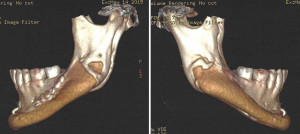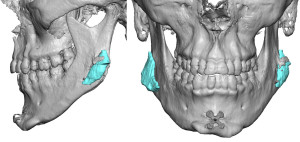Jaw angles implants are becoming increasingly popular for their jawline augmentation effects. Different styles of jaw angle implants allow for a variety of posterior jawline effects from widening, lengthening and combinations thereof. Like a chin implant they are placed in the subperiosteal submuscular position at the back of the jaw.
The difference in jaw angle implants, compared to almost any other site-specific facial implant, is their size. They are comparatively large and are placed under the largest muscle in the face, the masseter muscle. It is also a muscle that has a lot of repetitive activity as it is responsible for both its chewing effects as well as aiding in moving the lower jaw.

The bony overgrowth that develops is very thin and has the consistency of an eggshell. It easily flakes off the implant and is similarly easily removed from its attachment to the side of the jawbone from where it grew. it is interesting that it develops even on smooth silicone implant surfaces.
Bony overgrowth is seen in other facial implants and is a well observed finding in chin implants. It is commonly seen in chin implants that have developed some passive settling into the bone with new bone growing up along its side. While such implant settling is seen in chin implants I have not observed in jaw angle implants.
The source of the bone growth is undoubtably from the periosteum on the underside of the large masseter muscle’s inner surface that has been raised up off of the bone. This is a potent source of bone stimulation and growth.
Dr. Barry Eppley
Indianapolis, Indiana



